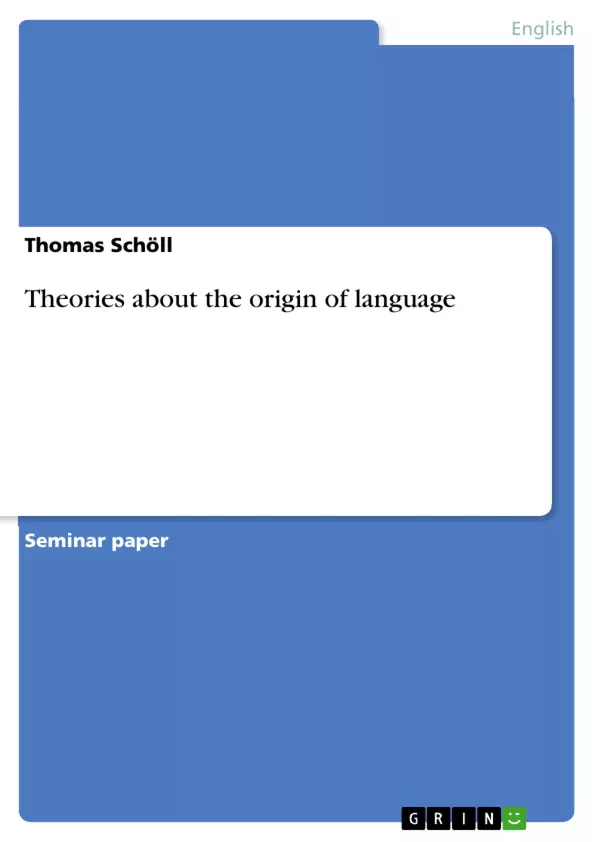I. Introduction
The following paper introduces certain theories about the origin of the human language. These theories will reveal to which degree we can give information about the origin of language and to what extent these information are speculative or not.
The first theories deal with the straight line of evolution. According to evolution, things change in the course of time and so the first theories are concerned with the development of language. These theories try to answer the question whether the development followed a straight line or not. The subsequent theories then deal with the religious and philosophical aspects in the theories about when language started. After that, biological theories are presented, before the closing of the essay with a summary and conclusion.
[...]
Table of Contents
- I. Introduction
- II. The Continuity Theories
- III. The Discontinuity Theory
- IV. Philosophical Theories and Religious Belief
- V. Biological Theories
- VI. Common lines of arguments about the relation of brain size, other skeletal features, intelligence and language
- VII. Summary and conclusion
Objectives and Key Themes
This paper aims to explore various theories regarding the origin of human language, examining the degree to which these theories offer factual information versus speculation. It investigates different perspectives on the evolutionary development of language, encompassing continuity and discontinuity theories.
- Evolutionary development of language (continuity vs. discontinuity)
- Comparison of human and animal communication
- Role of intelligence in language acquisition
- Biological prerequisites for language
- Philosophical and religious perspectives on language origins
Chapter Summaries
I. Introduction: This introductory chapter sets the stage for the paper by outlining its objective: to explore diverse theories surrounding the origin of human language and assess their respective levels of factual support versus conjecture. It briefly introduces the core themes that will be developed in subsequent chapters, namely the evolutionary trajectory of language (continuous versus discontinuous), and the integration of philosophical, religious, and biological perspectives on this crucial aspect of human development. The chapter provides a roadmap for the subsequent exploration of the complex issue of language origins, highlighting the diverse theoretical frameworks that will be examined.
II. The Continuity Theories: This chapter delves into theories positing a continuous development of language from animal communication. It argues that while a fundamental difference exists in the complexity and abstract capabilities of human language compared to animal communication, the underlying principles of communication—transmitting messages—are shared. The chapter explores the concept of "specific intelligence" as a key differentiator, acknowledging the limitations in directly comparing intelligence across species. It also examines a contrasting theory suggesting that individual language features have evolved independently throughout different species, creating a branching "family tree" of language development, highlighting the imperfections in using this analogy to explain the evolution of language.
Keywords
Human language origins, continuity theories, discontinuity theory, animal communication, specific intelligence, biological prerequisites, philosophical theories, religious beliefs, language evolution.
Frequently Asked Questions: A Comprehensive Language Preview
What is the main topic of this paper?
This paper explores various theories regarding the origin of human language, examining the degree to which these theories offer factual information versus speculation. It investigates different perspectives on the evolutionary development of language, encompassing continuity and discontinuity theories.
What are the key themes explored in the paper?
The key themes include the evolutionary development of language (continuity vs. discontinuity), a comparison of human and animal communication, the role of intelligence in language acquisition, the biological prerequisites for language, and philosophical and religious perspectives on language origins.
What are the different theories of language origin discussed?
The paper examines both continuity theories (positing a continuous development from animal communication) and discontinuity theories (suggesting a more abrupt emergence of human language). It also considers biological, philosophical, and religious perspectives on language origins.
How does the paper compare human and animal communication?
The paper acknowledges a fundamental difference in the complexity and abstract capabilities of human language compared to animal communication, but also explores shared principles of communication (transmitting messages). It discusses the concept of "specific intelligence" as a key differentiator, and the limitations in directly comparing intelligence across species.
What is the role of intelligence in language acquisition, according to the paper?
The paper investigates the role of intelligence in language acquisition, acknowledging the complexities of comparing intelligence across species and the limitations of using analogies like a branching "family tree" to explain language evolution.
What are the biological prerequisites for language, as discussed in the paper?
The paper explores the biological prerequisites for language, although specific details are not provided in the preview. This aspect is mentioned as one of the key themes investigated.
What are the philosophical and religious perspectives on language origins covered in the paper?
The paper includes a chapter dedicated to exploring philosophical theories and religious beliefs concerning language origins. However, specific viewpoints are not detailed in this preview.
What is the structure of the paper?
The paper is structured into seven chapters: an introduction, chapters dedicated to continuity and discontinuity theories, a chapter on philosophical and religious perspectives, a chapter on biological theories, a chapter on the relation between brain size, skeletal features, intelligence and language, and finally, a summary and conclusion.
What are the keywords associated with this paper?
Keywords include: Human language origins, continuity theories, discontinuity theory, animal communication, specific intelligence, biological prerequisites, philosophical theories, religious beliefs, language evolution.
- Quote paper
- Thomas Schöll (Author), 1996, Theories about the origin of language, Munich, GRIN Verlag, https://www.grin.com/document/12027



